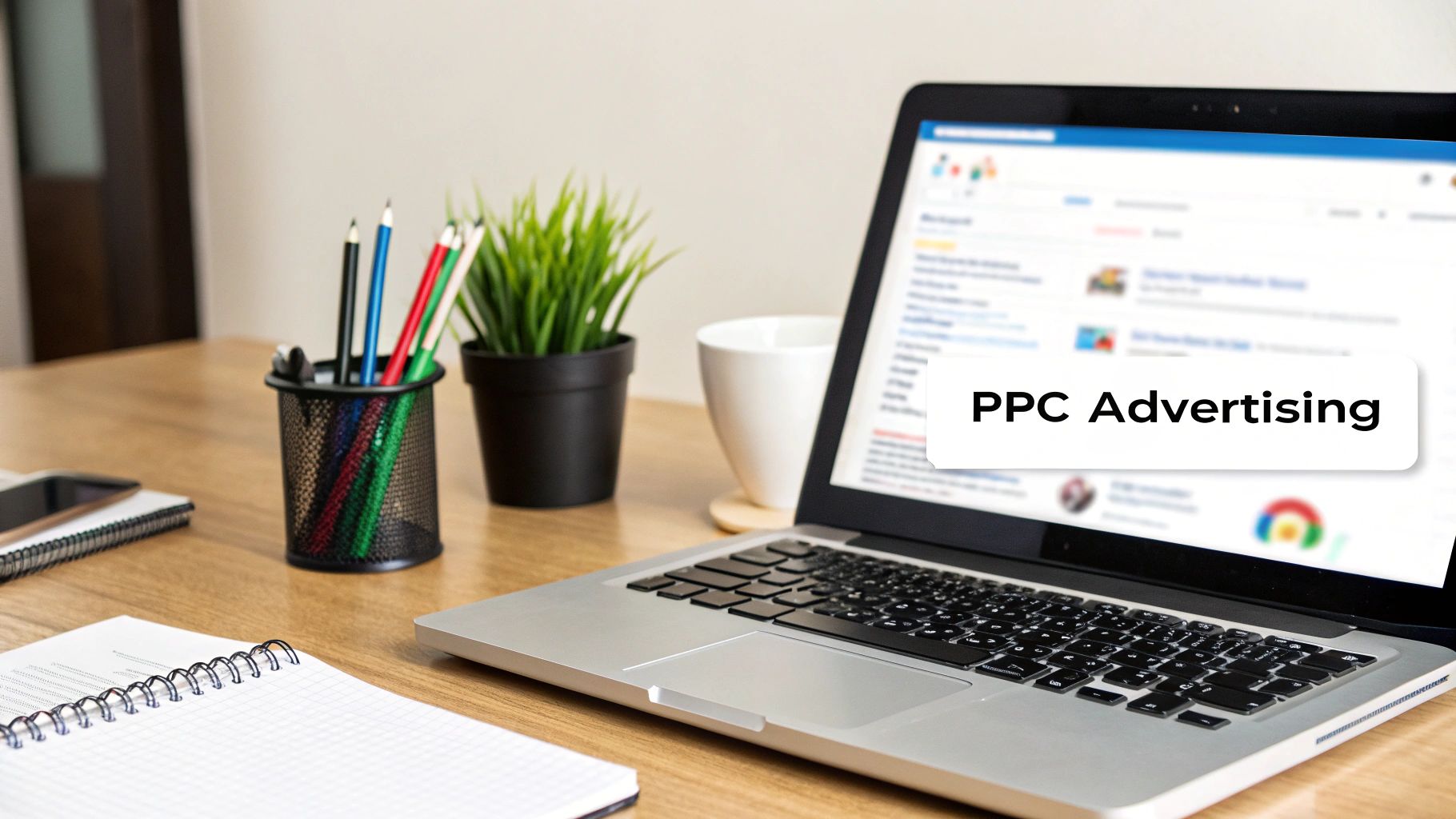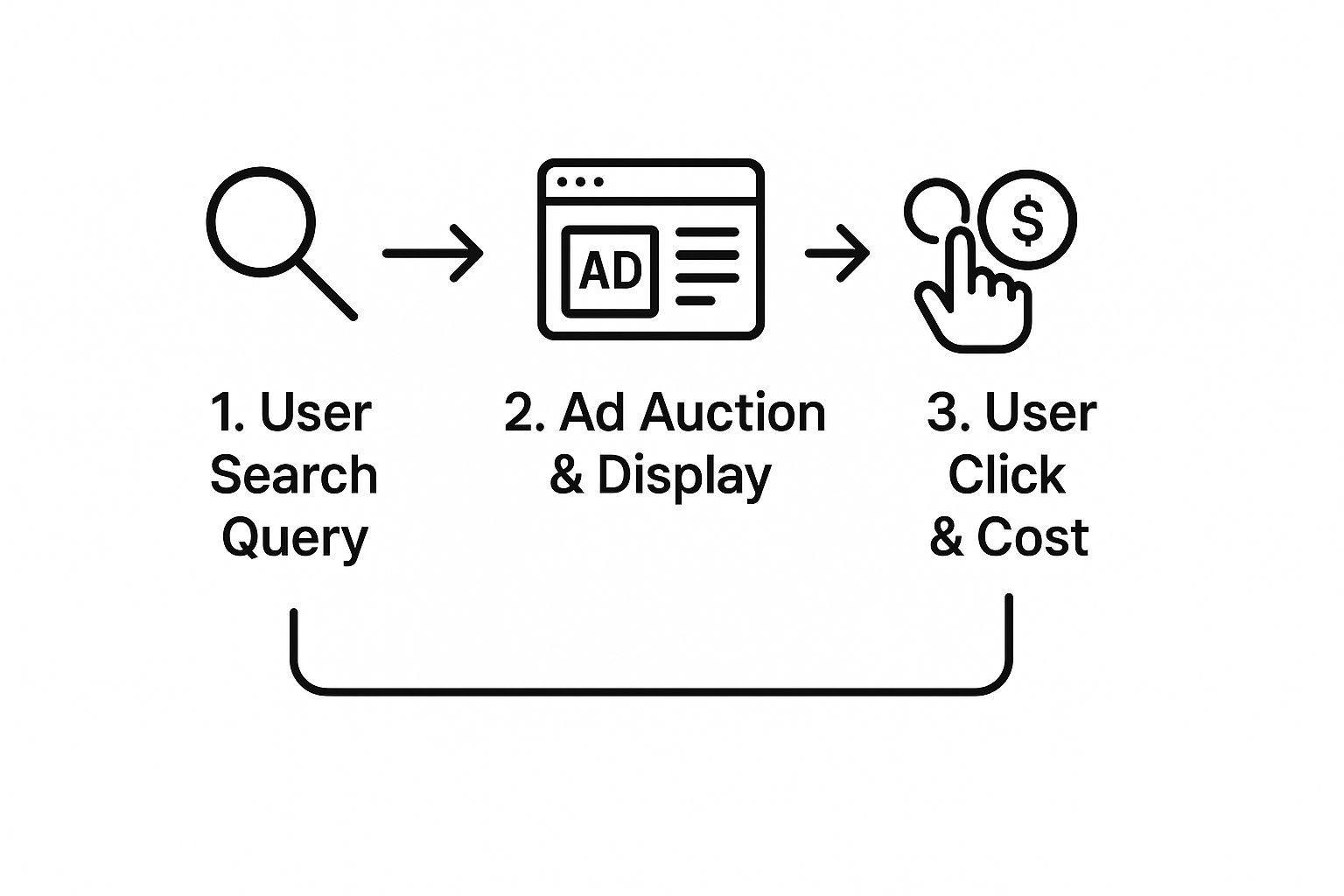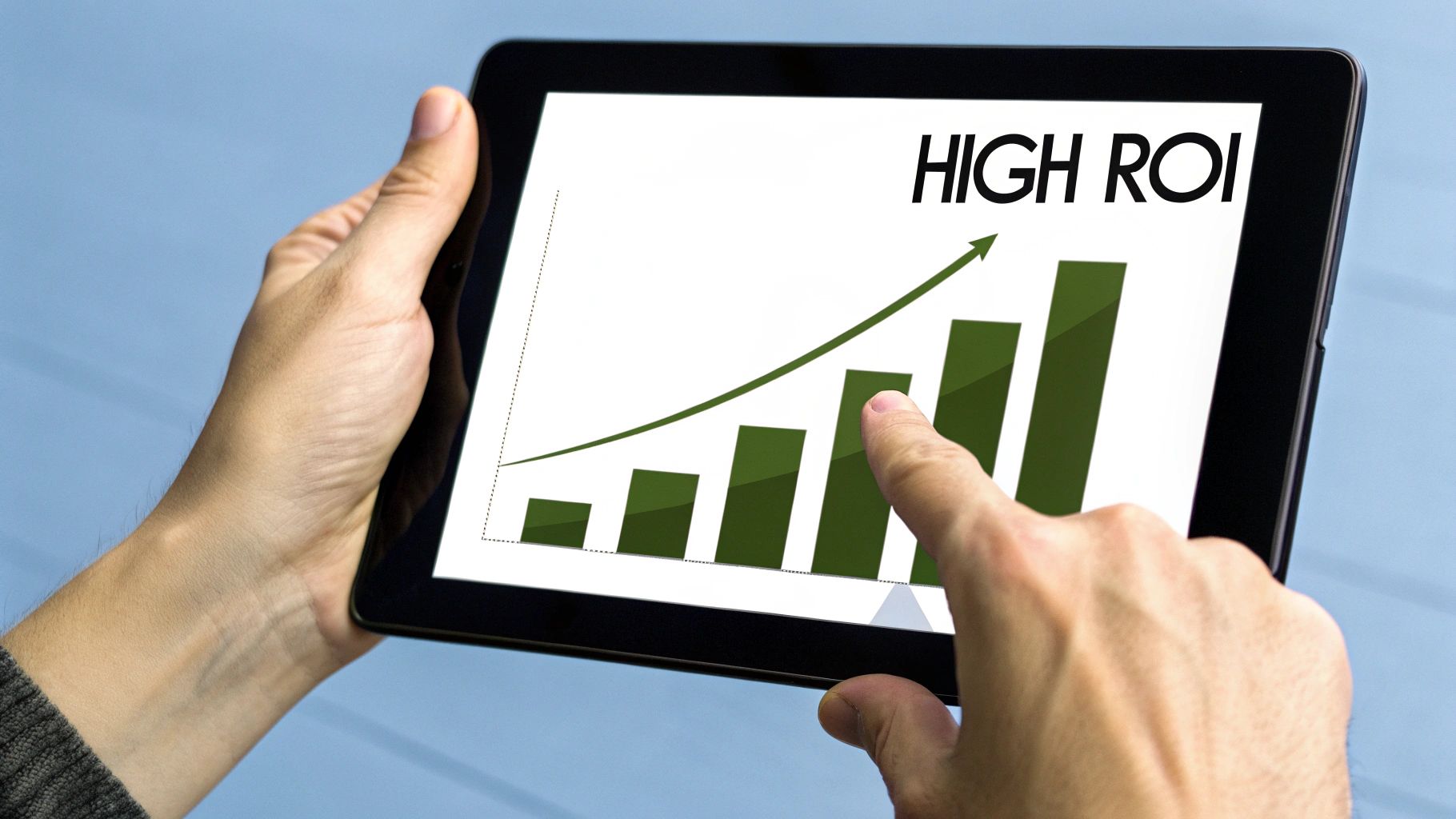What is PPC Advertising? Unlock Business Growth Today!

What is PPC Advertising? Pay-per-click (PPC) advertising is a straightforward but powerful online model where you only pay a fee when someone actually clicks on your ad. Instead of waiting to earn visits organically through SEO, PPC lets you buy targeted traffic from platforms like Google, putting your brand right in the eyeline of customers who are ready to buy.
Understanding PPC Advertising
 Think of it like this: traditional advertising is like paying for a massive billboard on the motorway, hoping the right people drive past. PPC completely flips that idea on its head. You only pay when someone not only sees your ad but is interested enough to pull over and walk into your shop. It’s an incredibly efficient way to spend your marketing budget.
Think of it like this: traditional advertising is like paying for a massive billboard on the motorway, hoping the right people drive past. PPC completely flips that idea on its head. You only pay when someone not only sees your ad but is interested enough to pull over and walk into your shop. It’s an incredibly efficient way to spend your marketing budget.
This “pay-for-performance” model is the beating heart of PPC. As an advertiser, you bid on keywords that are relevant to your business—the exact phrases your ideal customers are typing into search engines. When a user’s search query matches one of your keywords, a lightning-fast auction takes place to decide which ads get shown.
The Power of Intent: What is PPC Advertising?
What is PPC Advertising? The real magic of PPC is its ability to tap into a customer’s intent at the perfect moment. Someone searching for “emergency plumber near me” isn’t just browsing; they have an immediate, urgent problem that needs solving. By bidding on this keyword, a local plumber can get their ad in front of a customer who is actively looking to spend money, right now.
This direct line to motivated buyers is exactly why PPC is a primary growth engine for UK businesses. In fact, around 80% of firms rely on it to scale their operations. And with about 98% of UK consumers now researching products online, PPC has become a non-negotiable tool for making that connection.
Beyond Search Engines
While Google Ads is the platform that usually springs to mind, the PPC model stretches right across the web. Social media giants like Facebook and Instagram, e-commerce titans like Amazon, and other search engines such as Microsoft Ads all operate on a similar principle. Each platform offers its own unique ways to target audiences, whether it’s by their search terms, their demographics, or their online behaviour.
At its heart, PPC is about precision. It allows you to control who sees your ads, how much you spend, and what actions you measure, turning advertising from a guessing game into a data-driven strategy.
Ultimately, PPC provides a level of control and measurability that few other marketing channels can even dream of matching. It’s a crucial part of a wider strategy known as performance marketing, which you can read all about in our detailed guide on what performance marketing is.
How the PPC Ad Auction Actually Works
Every single time you search for something on Google, a lightning-fast auction kicks off behind the scenes. This auction decides which ads you see and in what order they appear. Getting your head around this process is fundamental to understanding PPC. It’s not just about who has the deepest pockets; it’s a much smarter system designed to reward quality.
Think of it like a talent show. The judges aren’t just impressed by the act that paid the most to get on stage; they care about the actual performance. In the world of PPC, search engines like Google are the judges, and they’re looking at two main things: your maximum bid and your Quality Score.
The whole process is a blink-and-you’ll-miss-it affair, starting with a user’s search and ending with an ad display and, hopefully for the advertiser, a click.
 As the infographic shows, the auction is an instantaneous response to someone showing they’re interested in something, which results in a paid click for the winning advertiser.
As the infographic shows, the auction is an instantaneous response to someone showing they’re interested in something, which results in a paid click for the winning advertiser.
Unpacking Quality Score
So, what is this Quality Score? It’s basically the platform’s rating of how relevant and high-quality your keywords and ads are. It’s scored out of 10, and while a few things feed into it, these are the big three:
- Ad Relevance: How well does your ad copy match what the person actually searched for? A truly relevant ad speaks directly to their query.
- Expected Click-Through Rate (CTR): Based on how your ad has performed in the past, how likely is it that people will actually click on it when they see it?
- Landing Page Experience: After someone clicks your ad, what happens next? Does the landing page give them what they were looking for? Is it easy to use, relevant, and trustworthy?
These elements work together to make sure users are shown ads that are genuinely helpful, which makes for a better experience all around. Nail these, and a high Quality Score can lead to cheaper clicks and better ad positions.
What is PPC Advertising? Calculating Your Ad Rank
To figure out where your ad actually shows up on the page, the platform calculates what’s called your Ad Rank. The formula is simple but incredibly powerful.
Ad Rank = Maximum Bid x Quality Score
This is where it gets interesting. An advertiser with a modest bid but a stellar Quality Score can easily leapfrog a competitor who’s throwing a huge budget at irrelevant, poor-quality ads. The system is built to reward advertisers for creating great experiences, not just for outspending everyone else. If you want to dive deeper into the nuts and bolts, you can learn more about how Google PPC works in our dedicated guide.
Ultimately, what you actually pay per click (your CPC) is decided by the Ad Rank of the advertiser just below you, divided by your own Quality Score, plus a tiny bit more. This means a higher Quality Score directly translates to paying less for each click to hold your spot. Simple as that.
Exploring the Main PPC Advertising Platforms

Jumping into PPC isn’t just about choosing an advertising model; it’s about picking the right digital arena to fight for your customers’ attention. Each platform is its own world, complete with a unique audience, different rules of engagement, and specific strengths. Getting your head around these differences is the first step toward building a strategy that actually delivers.
The big names in PPC advertising pretty much own the digital space, setting the terms for how businesses connect with people online. The money involved is staggering. In 2023, Google’s global ad revenue soared to $175 billion (about £138 billion), with Meta not far behind at $132 billion (£104.2 billion). But watch out for the newcomers – TikTok’s ad spend has exploded to $13 billion (£10.26 billion), showing just how quickly user attention can shift.
Search Engine Giants: Google Ads and Microsoft Ads
When it comes to search advertising, Google Ads is the undisputed king. Billions of searches happen every single day, giving you a direct line to high-intent users—people who are right now looking for the exact solutions you offer. If someone types in “best running shoes for marathon training,” your ad can be the first thing they see. It’s that immediate.
Microsoft Ads (which you might remember as Bing Ads) plays a similar game, just on a smaller field. It covers searches on Bing, Yahoo, and DuckDuckGo, and its audience often skews a bit older and more affluent than Google’s. This makes it a smart, and often cheaper, addition to your search strategy, helping you catch customers that others might miss.
What is PPC Advertising? Social Media Powerhouses: Meta and TikTok
While search ads are great for capturing existing demand, social media platforms are where you go to create it. Meta Ads, covering both Facebook and Instagram, is a masterclass in audience targeting. You’re not using keywords here; instead, you build a detailed picture of your ideal customer using data on their demographics, interests, and online behaviour.
This lets you introduce your brand to people who are a perfect fit but just haven’t heard of you yet. And then there’s TikTok, which has become essential for reaching younger audiences with snappy, engaging video content that blends right into their feed.
You can basically split PPC platforms into two camps: intent-based (like Google), where you’re answering a direct need, and interest-based (like Meta), where you’re interrupting someone’s scroll with a message you think they’ll like.
Figuring out where to start often comes down to your goals. If you need to drive immediate leads from people actively looking for what you sell, understanding the nuances of Google Ads vs Facebook Ads provides valuable insight into where to put your money first.
E-commerce Focused: Amazon Ads
If you sell physical products online, Amazon Ads is a non-negotiable part of your toolkit. It puts your products right in front of shoppers who are already on the platform with their wallets out, ready to buy. The real magic is how close your ad is to the final sale.
Unlike other platforms where a click takes someone to your website, an Amazon ad click keeps them right there in Amazon’s trusted shopping environment. This almost always leads to higher conversion rates for e-commerce brands, making it a powerful channel for driving sales and getting your products seen.
The Big Wins: What PPC Really Brings to Your Business
While some marketing channels are a slow burn, PPC advertising offers something most businesses crave: speed. Unlike SEO, which can take months to really get going, a smartly built PPC campaign can start funnelling targeted traffic to your website almost overnight. This makes it an absolute game-changer for launching new products, pushing time-sensitive offers, or just making a big splash in your market, fast.
This instant impact comes with an incredible amount of control. You’re in the driver’s seat for every part of your campaign, from how much you spend each day to the exact type of person you want to reach. You set the budget, and you can crank it up or dial it back down whenever you want, based on what’s working.
What is PPC Advertising? Find Your Perfect Customer with Pinpoint Targeting
The real magic of PPC is just how specific you can get with your targeting. You can go way beyond just general demographics and connect with your ideal customers based on incredibly detailed criteria. This precision means your budget is spent reaching people who are actually likely to buy, not just wasted on a crowd that isn’t interested.
This level of detail lets you get really granular:
- Geographic Targeting: Focus your ads on specific countries, cities, or even individual postcodes to pull in local customers.
- Demographic Targeting: Zero in on users based on their age, gender, whether they’re parents, and even their household income.
- Behavioural Targeting: Connect with people based on their recent online activities, what they’re interested in, and what they’ve been looking to buy.
What does this mean in the real world? A boutique clothing shop in Bristol could show its ads only to people within a five-mile radius who have recently searched for sustainable fashion. That’s a level of focus traditional advertising just can’t touch.
Crystal-Clear Results and ROI
Maybe the single biggest advantage of PPC is that everything is completely measurable. Every single pound you spend can be tracked and tied directly to a result, whether that’s a click, a new lead, or a sale. This data-first approach takes all the guesswork out of your marketing.
With PPC, you can calculate your Return On Ad Spend (ROAS) with pinpoint accuracy. This clarity allows you to make smart, informed decisions, shifting your budget to the campaigns, keywords, and ads that deliver the best results and drive real growth.
This transparency empowers businesses—especially smaller ones—to compete with the big players. To get a better feel for how this works in practice, you can dive into our guide on whether PPC advertising is effective for small businesses. By digging into the data, you also get priceless insights into what your customers actually respond to, helping you sharpen not just your ads but your entire business strategy.
Essential PPC Terms You Need to Know

To really get your head around PPC, you’ve got to speak the language. The world of paid advertising is swimming in acronyms and metrics, but trust me, they’re not as intimidating as they first appear.
Getting comfortable with these terms is the key to figuring out what’s working, what’s a waste of money, and how to steer your campaigns toward serious results.
The Building Blocks: Core Performance Metrics
What is PPC Advertising? First up, let’s talk about the absolute essentials. These are the core numbers that tell you how people are actually interacting with your ads. Think of them as the foundational pieces of any performance report you’ll ever look at.
- Cost-Per-Click (CPC): This one’s pretty straightforward – it’s the price you pay every single time someone clicks your ad. Consider it the entry fee for getting a potential customer through your digital front door and onto your website. Your CPC isn’t set in stone; it dances around based on how fierce the competition is, your ad’s Quality Score, and even your industry.
- Click-Through Rate (CTR): This is your ad’s charm-o-meter. CTR shows you the percentage of people who saw your ad (impressions) and were compelled enough to actually click it. A healthy CTR is a great sign that your ad copy and targeting are hitting the mark with your audience.
Imagine your ad is a shop window on a busy high street. The number of people walking past are your impressions. The CTR is the percentage of those people who stop, like what they see in your display, and decide to pop inside.
The Bottom Line: Measuring What Really Matters
Getting clicks is a great start, but it’s only half the battle. This next batch of terms zooms in on what happens after the click, connecting your ad spend to real-world business results. These are the metrics that tell you if your investment is actually paying off.
The whole point of PPC isn’t just to get traffic; it’s to drive actions that make your business money. Metrics like Conversion Rate and ROAS are how you prove that your campaigns are doing just that.
- Conversion and Conversion Rate: A conversion is the specific, valuable action you want someone to take after they click your ad. This could be anything from making a purchase or filling out a contact form to signing up for your newsletter. The Conversion Rate is simply the percentage of your clicks that turn into one of these conversions. This number tells you how good your landing page is at turning curious visitors into actual customers or leads.
- Cost Per Acquisition (CPA): Sometimes called Cost Per Action, CPA tells you the average cost to land one new customer or lead from your campaign. You figure it out by dividing your total ad spend by the number of conversions. For any business focused on generating leads, this is a non-negotiable metric – it tells you exactly what you’re paying to get a new prospect in the door.
- Return On Ad Spend (ROAS): For many campaigns, especially in e-commerce, this is the holy grail. ROAS measures how much revenue you’ve made for every single pound you’ve spent on ads. For instance, a ROAS of £5 means you’ve generated £5 in sales for every £1 you invested. It’s the ultimate measure of profitability.
Comparing Performance Metrics CPA vs ROAS
When you’re digging into campaign performance, two of the biggest players are CPA and ROAS. They both measure success, but they tell very different stories. Understanding when to use each one is crucial for setting the right goals and optimising your strategy effectively.
| Metric | What It Measures | When to Use It |
|---|---|---|
| CPA | The average cost to acquire a single lead or customer. | Ideal for lead generation campaigns where the immediate value of a lead is consistent or unknown. Focuses on efficiency. |
| ROAS | The amount of revenue generated for every pound spent on ads. | Perfect for e-commerce or any business where each conversion has a direct, measurable monetary value. Focuses on profitability. |
So, while CPA helps you keep lead costs under control, ROAS gives you a clear picture of how profitable your ad spend is. Both are incredibly useful, but you’ll lean on one more than the other depending on whether you’re chasing leads or direct sales.
Launching Your First PPC Campaign
Diving into your first PPC campaign can feel like a massive undertaking, but honestly, it’s much less daunting when you have a clear roadmap. A truly successful campaign doesn’t start with writing ads; it begins with solid, strategic planning. Your very first move? Figure out exactly what you want to achieve.
Are you trying to get the cash register ringing with direct website sales? Or maybe you’re looking to fill your pipeline with new leads by getting people to complete a contact form. It could even be that your initial goal is just to get your name out there, driving targeted traffic to build brand awareness. Nailing down a specific objective is your north star—it dictates every single decision you’ll make from here on out, from the keywords you choose to how you measure what’s working.
Building Your Foundation
Once you know your destination, it’s time to lay the groundwork. This is the stage where your big idea gets turned into a concrete, actionable plan.
Your first two steps are absolutely crucial:
- Set a Realistic Budget: Decide what you’re comfortable spending each day or month. It’s perfectly fine to start small. The key is to have a budget that lets you gather enough data to see what’s effective without emptying your pockets.
- Conduct Keyword Research: This is where you need to put yourself in your customer’s shoes. Use some tools to uncover the exact phrases and questions people are typing into search engines when they’re looking for what you sell. This research is the absolute bedrock of PPC, connecting your ads directly to people who are ready to buy.
A well-structured campaign is built around tightly themed ad groups. Think of each ad group as a small container focused on a cluster of closely related keywords. This ensures your ads are always super-relevant to what someone is searching for, which not only boosts performance but makes managing everything a whole lot simpler.
With your keywords sorted, your focus shifts to the things your potential customers will actually see and interact with. This means writing compelling ad copy that speaks directly to their problems and creating a dedicated landing page. This page needs to be laser-focused on one single thing—the conversion goal you set right at the start.
Finally, and this is non-negotiable, set up conversion tracking from day one. Without it, you’re just flying blind, with no real way of knowing which parts of your campaign are actually making you money.
Frequently Asked Questions About “What is PPC Advertising?”
It’s only natural to have a few questions when you’re getting to grips with PPC. To be honest, we’d be worried if you didn’t! We’ve put together some straight-talking answers to the questions we hear most often, helping you get a clearer picture of what PPC can really do for your business.
How Much Should I Spend on PPC?
This is the million-dollar question, isn’t it? The truth is, there’s no magic number. A solid starting point for many small businesses is a daily budget of anywhere from £10 to £50. This is usually enough to get the ball rolling and start gathering some valuable performance data.
But the real key is figuring out your target Cost Per Acquisition (CPA). Once you know exactly how much you’re willing to pay to win a new customer or get a new lead, you can work backwards and build a budget that actually makes sense for your business goals.
How Long Does It Take to See Results?
One of the best things about PPC is the speed. While SEO can feel like a long, slow climb, a PPC campaign can start sending traffic your way and collecting data within hours of going live. You flick the switch, and things start happening.
Now, seeing profitable results—that positive return on your investment—takes a bit more time. You should plan for an initial testing and optimisation phase of at least one to three months. This gives you the breathing room to tweak your targeting, polish your ads, and get your landing pages just right to deliver consistent, profitable growth.
What is PPC Advertising? Is PPC Better Than SEO?
Thinking of PPC and SEO as rivals is the wrong way to look at it. They’re two sides of the same digital marketing coin, and they are brilliant when they work together.
- PPC is all about speed and control. It’s perfect for driving instant traffic, running targeted promotions, and quickly testing out new ideas or offers.
- SEO is your long game. It’s about building sustainable, organic growth and authority over time, which often leads to a much lower cost per customer in the long run.
A savvy digital marketing strategy uses PPC to capture immediate demand and scoop up valuable keyword insights. At the same time, it invests in SEO to build a rock-solid foundation for future organic success. One feeds the other, making your overall strategy much stronger.
Ready to stop guessing and start getting real results from your advertising spend? The team at PPC Geeks builds data-driven campaigns that deliver measurable growth. Book your free PPC audit today and discover how our experts can help you succeed.
Author
Search Blog
Free PPC Audit
Subscribe to our Newsletter
The Voices of Our Success: Your Words, Our Pride
Don't just take our word for it. With over 100+ five-star reviews, we let our work-and our satisfied clients-speak for us.
"We have been working with PPC Geeks for around 6 months and have found Mark and the team to be very impressive. Having worked with a few companies in this and similar sectors, I rate PPC Geeks as the strongest I have come across. They have taken time to understand our business, our market and competitors and supported us to devise a strategy to generate business. I value the expertise Mark and his team provide and trust them to make the best recommendations for the long-term."
~ Just Go, Alasdair Anderson
